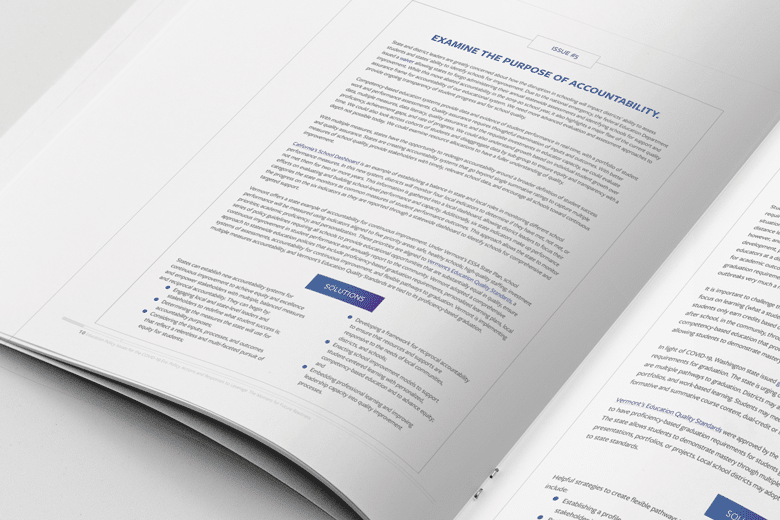Examine the Purpose of Accountability
Education Domain Blog
 State and district leaders are greatly concerned about how the disruption caused by COVID-19 will impact the ability to assess students and identify schools for improvement. Competency-based education systems provide data and evidence of student performance in real-time, with a portfolio of student work and performance assessments. With better data, multiple measures, data literacy, quality assurance, and the requisite investments in educator capacity, we could evaluate proficiency, achievement gaps, rate of progress, and also understand growth based on individual student growth over time.
State and district leaders are greatly concerned about how the disruption caused by COVID-19 will impact the ability to assess students and identify schools for improvement. Competency-based education systems provide data and evidence of student performance in real-time, with a portfolio of student work and performance assessments. With better data, multiple measures, data literacy, quality assurance, and the requisite investments in educator capacity, we could evaluate proficiency, achievement gaps, rate of progress, and also understand growth based on individual student growth over time.
States can establish new accountability systems for continuous improvement to achieve equity and excellence and empower stakeholders with multiple, balanced measures and reciprocal accountability. They can begin by:
- Engaging local and state-level leaders and stakeholders to redefine what student success is;
- Determining the measures the state will use for accountability purposes;
- Considering the inputs, processes, and outcomes that reflect a relentless and multi-faceted pursuit of equity for students;
- Developing a framework for reciprocal accountability to ensure that resources and supports are responsive to the needs of local communities, districts, and schools;
- Enacting school improvement models to support student-centered learning with personalized, competency-based education and to advance equity; and
- Embedding professional learning and improving leadership capacity into quality improvement processes.
Due to the national emergency, the U.S. Department of Education issued a waiver allowing states to forgo administering their annual statewide assessments and identifying schools for support and improvement. Although this move abated accountability in the 2019-20 school year, it also highlights a major flaw of the current quality assurance frame for accountability of our educational system. We need more advanced evaluation and assessment approaches to provide ongoing transparency of student progress and for school quality.
State Highlights
California’s School Dashboard is an example of establishing a balance in state and local roles in monitoring different school performance measures. In this new system, districts will monitor four local indicators to determine if they have met, not met, or not met them for two or more years. This information is gathered into a local dashboard, allowing district leaders to focus their efforts on evaluating and building school-level performance and capacity. Additionally, six state indicators make up performance categories the state monitors as common measures of student performance outcomes. This approach allows the state to monitor the progress on the six indicators as they are reported through a statewide dashboard, to identify schools for comprehensive and targeted support.
Vermont offers a state example of accountability for continuous improvement. Under Vermont’s ESSA State Plan, school performance will be measured using indicators aligned to five priority areas: safe, healthy schools; high-quality staffing; investment priorities; academic proficiency; and personalization. These priorities are aligned to Vermont’s Education Quality Standards, a series of policy guidelines requiring all schools to provide educational opportunities which are substantially equal in quality, ensure continuous improvement in student performance, and annually report to the community. Vermont adopted a comprehensive approach to statewide education policies that include proficiency-based graduation requirements, personalized learning plans, local systems of assessments, accountability for continuous improvement, and flexible pathways to graduation. Vermont is implementing multiple measures of accountability, and Vermont’s Education Quality Standards are tied to its proficiency-based graduation.
Other Posts in This Series
- Blog #1 – States Can Support Blended, Competency-Based Learning as an Entry Point for Innovation
- Blog #2 – Move Away from Seat Time Credits to Awarding Credit Based on Demonstrated Mastery
- Blog #3 – Grading Policies Need to Be Re-Examined to Support the Shift to Competency-Based Education
- Blog #4 – Rethink Assessment and Address the Need for Balanced Systems of Assessments for Measuring Student Learning